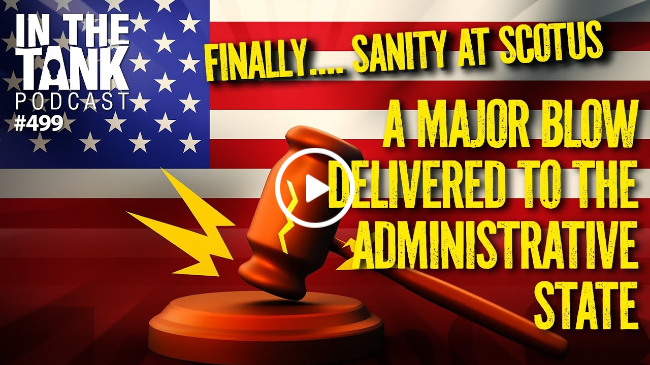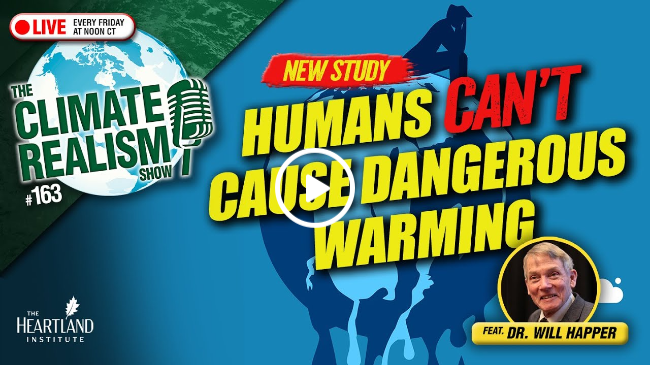Life, Liberty, Property #108: Supreme Court Affirms Constitutional Limit on Courts’ Authority
Forward this issue to your friends and urge them to subscribe.
Read all Life, Liberty, Property articles here, and full issues here and here.
IN THIS ISSUE:
- Supreme Court Affirms Constitutional Limit on Courts’ Authority
- Video of the Week: SCOTUS Slaps the Admin State—And Obama Wants Censorship? (In The Tank #499)
- Court Upholds Separation of Powers in Texas Case
- Emergency Management Revolution
- Cartoon
- Bonus Video of the Week: Physicists Debunk Net Zero: No Dangerous Warming from CO2 — The Climate Realism Show #163
Eminent Domain Case Tests Our Understanding of Federalism

Within a flurry of highly consequential and groundbreaking U.S. Supreme Court decisions, Friday’s ruling in Trump, President of the United States, et al. v. Casa, Inc., et al. stands out as a truly historic event. The Court ruled 6-3 that the Constitution does not allow federal courts to impose universal injunctions against actions of the president of the United States.
This is one of the most important blows against judicial overreach yet achieved by the Roberts court. The Court’s ruling, written by Associate Justice Amy Coney Barrett (the most thoroughly proceduralist of the current justices), properly disposes of the injunction as a procedural matter, taking no position on the case’s arguments over the interpretation of the Nationality Act. The Court’s decision firmly settles a much more fundamental and extensive issue, applying a constitutional rule that its predecessors ignored for decades:
The Executive Order identifies circumstances in which a person born in the United States is not “subject to the jurisdiction thereof” and is thus not recognized as an American citizen. The plaintiffs allege that the Executive Order violates the Fourteenth Amendment’s Citizenship Clause, §1, and §201 of the Nationality Act of 1940. In each case, the District Court entered a “universal injunction”—an injunction barring executive officials from applying the Executive Order to anyone, not just the plaintiffs. And in each case, the Court of Appeals denied the Government’s request to stay the sweeping relief. …
The applications do not raise—and thus the Court does not address—the question whether the Executive Order violates the Citizenship Clause or Nationality Act. Instead, the issue the Court decides is whether, under the Judiciary Act of 1789, federal courts have equitable authority to issue universal injunctions.
Held: Universal injunctions likely exceed the equitable authority that Congress has given to federal courts. The Court grants the Government’s applications for a partial stay of the injunctions entered below, but only to the extent that the injunctions are broader than necessary to provide complete relief to each plaintiff with standing to sue.
The Court’s decision in Trump et al. v. Casa, Inc., et al. is truly momentous, as it restores the original constitutional principle that federal courts are authorized only to decide the disposition of specific cases, not to establish universal decisions striking down all enforcement of the laws attended to in a particular case before the court:
If anything, the approach traditionally taken by federal courts cuts against the existence of such a sweeping remedy. Consider Scott v. Donald, where the plaintiff successfully challenged the constitutionality of a law on which state officials had relied to confiscate alcohol that the plaintiff kept for personal use. See 165 U. S. 107, 109 (statement of case); id., at 111–112 (opinion of the Court). Although the plaintiff sought an injunction barring enforcement of the law against both himself and anyone “whose rights [were] infringed and threatened” by it, the Court permitted only relief benefitting the named plaintiff. Id., at 115–117. In the ensuing decades, the Court consistently rebuffed requests for relief that extended beyond the parties.
The Court’s Friday decision cites multiple precedents that affirm this principle, observing, “‘[N]either declaratory nor injunctive relief,’ the Court has said, ‘can directly interfere with enforcement of contested statutes or ordinances except with respect to the particular federal plaintiffs.’ … In fact, universal injunctions were conspicuously nonexistent for most of the Nation’s history. Their absence from 18th and 19th century equity practice settles the question of judicial authority.”
The decision thus reflects originalism as well as proceduralism: “Under the Court’s well-established precedent, see Grupo Mexicano, 527 U. S., at 319, because universal injunctions lack a founding-era forebear, federal courts lack authority to issue them,” the Court rules.
The Court’s decision explicitly rejects the notion that federal courts have greater constitutional authority than the president: “When a court concludes that the Executive Branch has acted unlawfully, the answer is not for the court to exceed its power, too.”
In dissent, Associate Justice Ketanji Brown Jackson argued for unlimited judicial supremacy and accused the majority of refusing to respect the rule of law. Jackson’s dissent attempts to make what she describes as “a key conceptual point: The Court’s decision to permit the Executive to violate the Constitution with respect to anyone who has not yet sued is an existential threat to the rule of law.” The courts have the authority and in fact responsibility to decide … everything, Jackson argues:
Stated simply, what it means to have a system of government that is bounded by law is that everyone is constrained by the law, no exceptions. And for that to actually happen, courts must have the power to order everyone (including the Executive) to follow the law—full stop. To conclude otherwise is to endorse the creation of a zone of lawlessness within which the Executive has the prerogative to take or leave the law as it wishes, and where individuals who would otherwise be entitled to the law’s protection become subject to the Executive’s whims instead.
In short, Jackson would make the courts a collective monarch. Barrett’s treatment of this argument is a thorough demolition that applies also to the numerous lower-court judges who have taken this same position to undermine the hated Trump’s legitimate authority as president:
We will not dwell on JUSTICE JACKSON’s argument, which is at odds with more than two centuries’ worth of precedent, not to mention the Constitution itself. We observe only this: JUSTICE JACKSON decries an imperial Executive while embracing an imperial Judiciary.
No one disputes that the Executive has a duty to follow the law. But the Judiciary does not have unbridled authority to enforce this obligation—in fact, sometimes the law prohibits the Judiciary from doing so. … Observing the limits on judicial authority—including, as relevant here, the boundaries of the Judiciary Act of 1789—is required by a judge’s oath to follow the law.
JUSTICE JACKSON skips over that part. Because analyzing the governing statute involves boring “legalese,” post, at 3, she seeks to answer “a far more basic question of enormous practical significance: May a federal court in the United States of America order the Executive to follow the law?” Ibid. In other words, it is unecessary [sic] to consider whether Congress has constrained the Judiciary; what matters is how the Judiciary may constrain the Executive. JUSTICE JACKSON would do well to heed her own admonition: “[E]veryone, from the President on down, is bound by law.” Ibid. That goes for judges too.
Amid that ferocious thrashing of the hapless Jackson, the decision strikes down the premise behind the entire multitude of lower-court decisions that have impeded the president from performing his duty to execute the laws. As Newsweek observes,
It’s a win for Trump, whose executive orders have been held up in the courts as judges issue injunctions temporarily pausing many from taking effect as legal cases challenging those policies make their way through the legal system. These injunctions have been a check on executive authority from Democratic and Republican presidents in recent years.
That makes this ruling one of the most sweeping and significant decisions since Dobbs v. Jackson Women’s Health Organization in 2022 overturned the Court’s 1973 decision in Roe v. Wade which had negated all state laws regarding abortion and substituted the Supreme Court’s policy decision for those made by the states.
The big question that remains is whether the Supreme Court will see fit to apply this principle to its own power of judicial review, especially as applied to the Executive and Legislative branches of the federal government. There is a strong case to be made for that, as Southern Illinois University professor emeritus Robert Lowry Clinton argued in a 2020 paper published by The Heritage Foundation:
Of course, courts have the raw power to make any constitutional ruling that they like in a case before them, but their legitimate authority to overrule the decisions of other branches of government extends only to cases of a judiciary nature and to clear, unarguable constitutional violations. This means that when a court overturns a legislative or executive act in a doubtful case not of a judiciary nature, the affected branch is not constitutionally bound to honor that decision as it pertains to other non-parties not before the court. That is because, in such a case, though the court had the power to decide the case, it did not have the constitutional authority to bind Congress and the President to its ruling.
The limited form of judicial review established in the Founders’ Constitution allows the judicial branch to protect itself against encroachments of other branches of government, to protect individual rights in clear cases in which another branch of government has unarguably violated the Constitution, and to perform the critical judicial function of resolving disputes peacefully and in accordance with standing law. It does not allow the courts to deny the other branches of government the power to interpret the Constitution for themselves within their own acknowledged constitutional spheres of authority.
That is the next issue to be resolved in this Court’s ongoing attempt at restoration of constitutional principles and the limits of authority among the separate branches of government. Although the rulings in particular cases may frustrate people’s political goals, the Court is moving in the right direction. Those in all three branches of the federal and state governments are to be “bound by Oath or Affirmation, to support this Constitution,” Article VI states. Courts, legislatures, and executives have ignored that oath for decades.
The need now is for a return to constitutional principles in which the legislature legislates, the executive executes, and the judges judge the cases before them and only the cases before them.
Sources: Supreme Court of the United States; Newsweek; The Heritage Foundation

Video of the Week

A series of SCOTUS rulings is dealing meaningful blows to the Administrative State, along with other courtroom wins for Trump and conservative interests. Meanwhile, having learned nothing from the collapsing fact-checker establishment, Obama says the government must crack down on “misinformation” posted online.

Court Upholds Separation of Powers in Texas Case

In another Friday ruling affirming the constitutional separation of powers, the U.S. Supreme Court upheld the constitutionality of a Texas law requiring websites that purvey sexual content to verify that their visitors are adults. The Wall Street Journal reports:
In a 6-3 decision, the court upheld the Texas law, which is among more than 20 that have passed by states in recent years requiring age verification for users seeking to access pornographic content online.
“The power to require age verification is within a state’s authority to prevent children from accessing sexually explicit content,” Justice Clarence Thomas wrote for the court’s conservative majority.
One might well describe “the court’s conservative majority” as “the court’s majority” and leave it at that, but evidently the temptation is too great when the justices rule against pornographers and other heroic nonconservatives. As to the premises behind the decision, the Journal story notes that the majority found the Texas law to be consistent with others that have already been accepted as constitutionally sound:
The state has argued that it was imposing the same kind of legitimate restrictions on pornographic content in the digital realm as there already are for similar content peddled by bricks-and-mortar retailers.
Thomas noted in his opinion that the need for age verification online was even greater than in person.
“Unlike a store clerk, a website operator cannot look at its visitors and estimate their ages,” he wrote. “Without a requirement to submit proof of age, even clearly underage minors would be able to access sexual content undetected.”
The minority judges, no pun intended, argued that the law should have been more finely tailored to avoid impeding any Texas adult’s access to revenge porn videos and other such important “speech,” under the legal principle of strict scrutiny. “To survive strict scrutiny, a law must be narrowly tailored, advance a compelling government interest, and be the least restrictive option available,” the Journal reports.
The majority applied rational basis review instead, which requires only a legitimate state interest for a law to stand. Instead of quibbling over whether the law could have been written more precisely to the minority justices’ liking (if the minority was in fact sincere in its arguments and not just looking for any old excuse to strike it down), the majority rightly allowed the Texas legislature, the governor, and the state’s voters to decide the matter. That is exactly what respect for the separation of powers requires.
Source: Supreme Court of the United States; The Wall Street Journal
NEW Heartland Policy Study
‘The CSDDD is the greatest threat to America’s sovereignty since the fall of the Soviet Union.’

Emergency Management Revolution

Grassroots groups are preparing to pick up the slack as the federal government reduces funding for the Federal Emergency Management Agency (FEMA), The New York Times reports.
The story describes these efforts in highly positive terms. It starts by reporting on “Rescue HQ, a gathering in rural Tennessee last month where the founding members of several newly formed disaster response groups ran through emergency scenarios and discussed how to better coordinate in the chaotic aftermath of a storm or a flood.” These organizations “are growing in number—a new model of disaster response taking shape outside of government channels,” the story states. “Many volunteers are deeply religious and have military backgrounds.”
Of course, this being The New York Times, the reporters drag in old you-know-who as villain:
They’re an unequal match for what the government can do, especially when it comes to long-term rebuilding efforts after natural disasters. But with the Trump administration pulling back staffing and funding for the Federal Emergency Management Agency—and even pledging to eliminate it—communities may soon rely far more on volunteer help.
“The bigger the gap is in terms of what the government isn’t doing, the more we’re going to expect from nonprofits and the larger their role is going to be,” said Daniel Sledge, a professor at the University of Oklahoma who has studied disaster relief. “Whether nonprofits actually have the capacity or the ability to step in and fill in the gaps that, in all likelihood, we’re going to be creating is a completely different question.”
Trump has said that he wants to phase out FEMA after this year’s hurricane season “and shift much of its responsibilities to the states,” the Times reports. Homeland Security Director Kristi Noem said the changes “will empower governors to go out and respond” to emergencies, the story reports.
The Trump administration has imposed major staff cuts at FEMA, the story states:
Already, FEMA has lost at least a quarter of its full-time staff since Mr. Trump took office in January, according to a former senior official who spoke on the condition of anonymity to not jeopardize a new job. That number includes career officials who helped coordinate immediate disaster response and leaders who oversaw the most hurricane-prone regions in the country.
The last sentence suggests that the staff cuts will undermine FEMA’s ability to respond to disasters. The reporters mention last year’s botched response to Hurricane Helene as evidence of “what gaps might be there in the absence of FEMA”: “The scale of devastation from Helene, and the difficulty navigating flooded, mountainous terrain in its aftermath, kept government aid from reaching some remote communities right away,” the story states.
That disproves the writers’ implicit argument against Trump’s policies, of course, given that (1) FEMA existed when Helene hit (there was no “absence”), (2) the Helene failure occurred long before any Trump budget cuts, and (3) Joe Biden, not Trump, was (supposedly) president at the time. It seems obvious that the Biden administration imposed these response deficiencies for political reasons, denying help in states and locales that generally vote for Republicans. Using disaster relief as a political tool is simply contemptible.
The cuts to FEMA’s budget, by contrast, are politically neutral and reflect a coherent philosophy. Trump’s plan to return this responsibility to the states and to the people harkens back to the common approach to all sorts of problems before the federal government began to take over more and more areas of private activity and squeeze out charitable efforts during the Progressive Era in the early years of the twentieth century, which accelerated during the New Deal under President Franklin Roosevelt.
The notion that the national government is the best place for coordinating and executing responses to natural disasters was widely seen as a good argument for centralization during the past century. A more likely motivation for the federal takeover, however, was the opportunity to accumulate more power in the central government and hand out large amounts of money to political friends.
Any plausible belief in the supposed coordination and performance advantages was swept away by the much-criticized federal response to the massive damage by Hurricane Katrina in 2005, and last year’s Helene fiasco confirmed the case for cynicism. The Times story reports,
A flurry of new disaster response groups sprang up last fall, as residents of western North Carolina expressed deep frustrations with the government’s response to Hurricane Helene’s catastrophic flooding. These groups were sometimes the first to reach people in isolated parts of the region.
“Us private citizens, we can get in there—if we’re one state over, we could hook up our trailers and get in there,” said Austin Fryer, 23, a member of one such group, the Christian Rangers. “FEMA—they have all this large amount of stuff that has to be organized, it has to accounted for. It can’t just be handed out willy-nilly.”
It won’t be easy for these groups to overcome the logistical challenges before them, the story notes, though the reporters create a false picture by failing to mention what the state governments can and surely will do in responding to natural disasters:
Newer groups need to develop detailed protocols and reliable funding streams to make sure that their work is sustainable and reputable, and that it doesn’t hinder the work of local officials, said Brian Trascher, the vice president of the United Cajun Navy, which formed in Louisiana after Hurricane Katrina. Members of his group worked with some of the groups in Kentucky after the tornadoes.
“We’ve turned into a full-fledged logistical disaster response group,” he said, adding that the organization’s practices had been shaped over the years by lessons learned in each successive disaster. Regardless of what happens to FEMA, he said, nonprofit groups like his are better positioned to assist with on-the-ground relief because they can be more nimble.
Although the political spin and inattention to state government efforts (which is even more inexcusable given that the writers know the Trump administration expects the states to take on this responsibility) mar the Times story, the phenomenon it reports on is an important one. It shows that the classical liberal, small-government approach has it right: people can largely take care of themselves and one another without intervention by a massive federal government.

via Townhall
Bonus Video of the Week

Two of the most prestigious physicists in America have written a new paper explaining why greenhouse gases (GHG) produced by human activity — namely carbon dioxide — cannot cause dangerous warming on the planet. Based on their findings, Dr. Will Happer and Dr. Richard Lindzen urge Congress to repeal all Net Zero subsidies, all laws requiring GHG emission reductions, and all restrictions on fossil fuel development and infrastructure.

Contact Us
The Heartland Institute
3939 North Wilke Road
Arlington Heights, IL 60004
p: 312/377-4000
f: 312/277-4122
e: [email protected]
Website: Heartland.org






